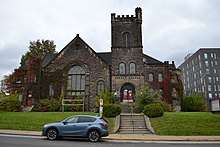Albright United Methodist Church
The Albright United Methodist Church is located at 486 S. Graham Street at the nexus of the Bloomfield, Shadyside, and Friendship neighborhoods of Pittsburgh, Pennsylvania. The church was designed by architect Chancey W. Hodgdon in an Eclectic, Richardson Romanesque style with prominent elements of Gothic Revival, and was built in 1905-1906.[1]
 The church in 2018 | |
 Location of the Albright United Methodist Church in Pittsburgh | |
| Location | 486 S. Graham St. Pittsburgh, Pennsylvania, USA |
|---|---|
| Coordinates | 40°27′24.74″N 79°56′12.88″W |
| Area | Bloomfield, Shadyside, and Friendship |
| Built/founded | 1905-06 |
| Architect | Chancey W. Hodgdon |
| Governing body/ | United Methodist Church of Western Pennsylvania |
History
The congregation for the Albright United Methodist Church was formed in 1843, and was formally organized in 1845 as the Zion Church of Pittsburgh of the Evangelical Association.[2] The congregation originally worshiped in numerous temporary locations in downtown Pittsburgh. The first two permanent locations also were located in Downtown in the 1850s. However, with the development of the Pennsylvania Railroad lines in Pittsburgh many residents decided to relocate to the eastern suburbs, and the churches began to leave to follow their congregations. The Zion Evangelical Church decided in 1905 to move eastward as well. In August of that year, the church purchased a lot to build on.[3] The construction for the church was finished on July 1st, 1906, and service began shortly after.[4] Since then the church has been renamed twice, first as the First Evangelical United Brethren Church, and then as the Albright United Methodist Church, which remains the name today. The church was nominated in September of 2015 to become a City Historic Landmark by Preservation Pittsburgh.
Architecture
Although relatively unknown, the architect Chancey W. Hodgdon’s canon of work is Pittsburgh-based and samples design elements from many architectural periods. The Church is one of Hodgdon’s most well-known works and is designed in an Eclectic style with samples of Richardson Romanesque traditions. The Church’s strong massing, rough-hewn rusticated stone, recessed doorways, large arches, and short columns are all reminiscent of this architectural styling.[5] These elements are mixed with a medieval crenelation at the roofline and stained glass to include elements of the Gothic Revival style in the building. The design is a small complex of two structures, the church and the parsonage, connected by a single story hyphen. The building is made of masonry and wood, while the church is a roughhewn Cleveland bluestone.[6] The stained glass windows are traced back to S.S. Marshall and Bros, one of the oldest art glass studios in the country that continued to make pressed flint and lime glass. The church’s 39 stained glass windows makes it home to the largest collection of S.S. Marshall Studio stained glass in Pittsburgh.[7]
References
| Wikimedia Commons has media related to Albright United Methodist Church. |
- E.L. Farren. Plan of the Property Situated in the 20th Ward Pittsburgh Pa., Surveyed for the Trustees of the Zion Church. 22 September 1905.
- Historical Sketch of the First Evangelical Church of Pittsburgh, Congregation Files, 1923
- Deed of Sale from Sue E. Holmes, Executrix of the Last Will and Testament of John G. Holmes to Zion Church of Pittsburgh of the Evangelical Association, 11 August 1905 (recorded 6 September 1905), Allegheny County, Pennsylvania, Vol. 1421, Page 68, Allegheny County Recorder of Deeds Office, Pittsburgh, Pennsylvania.
- “New Zion Church is Finished and Will Be Dedicated for Divine Service July 1.” Pittsburgh Chronicle Telegraph. 6 June 1906.
- Pennsylvania Historical and Museum Commission. “Romanesque Revival Style: 1840-1900.” ,http://www.portal.state.pa.us/portal/server.pt/community/late_victorian_period/2389/romanesque_revival _style/294764> Accessed: 9 August 2015.
- Charles S. Smith. Charles S. Smith to Building Committee Zion Church of the Evangelical Association, 9 August 1905. Letter.
- "Preservation Success! Albright is Pittsburgh's Newest Historic Landmark". Preservation Pittsburgh. September 26, 2016.